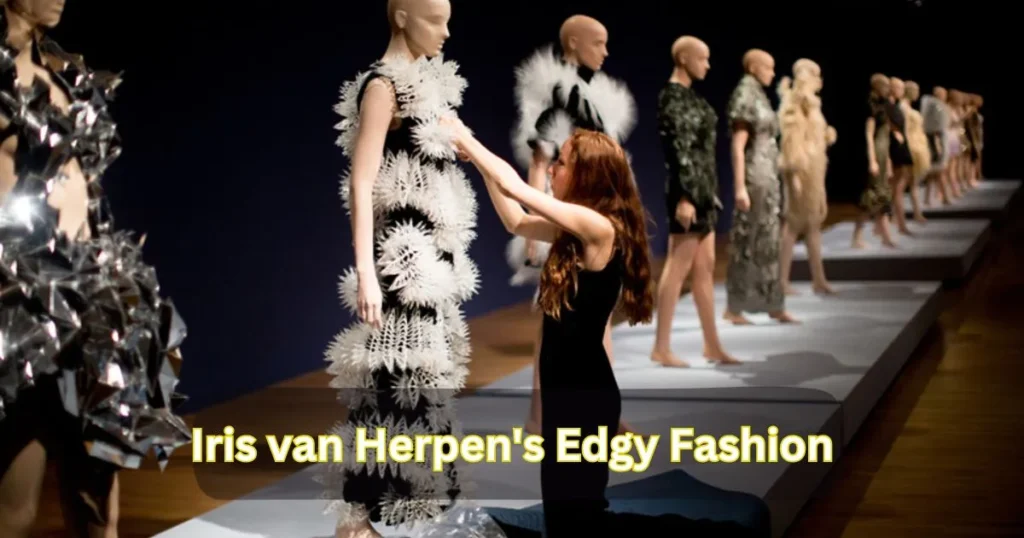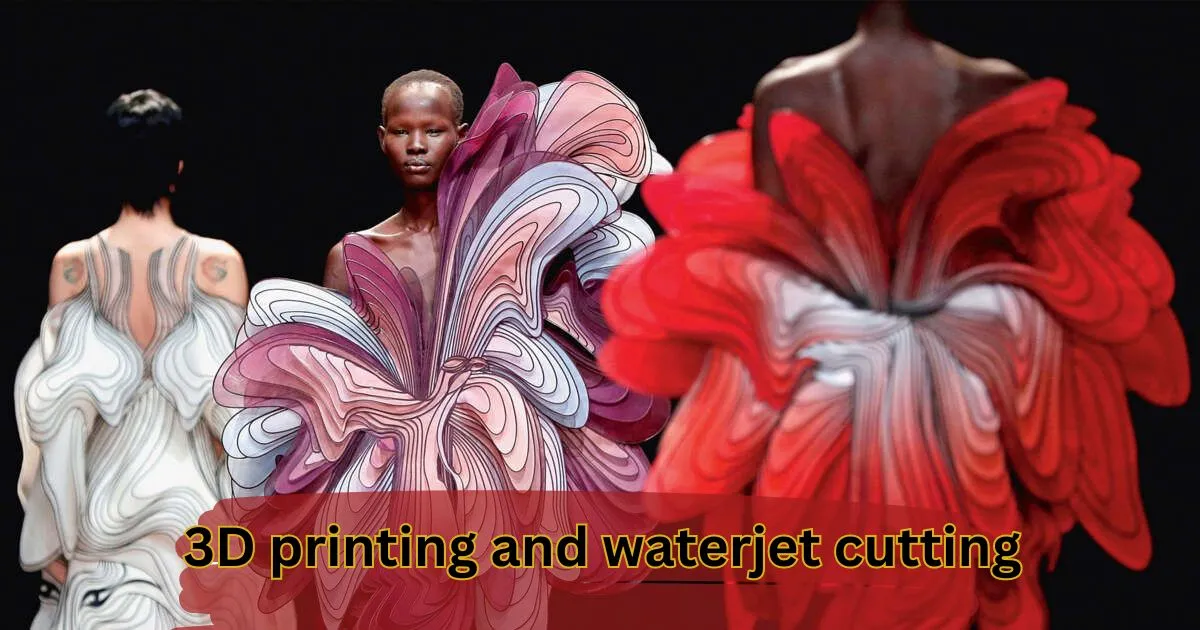Iris van Herpen’s Edgy Fashion is an immersive retrospective that will be on display at the Museum of Decorative Arts in Paris until April 28, 2024. It combines fashion with artwork, layout, and technical know-how?
Step right into a sensory journey via Iris van Herpen’s universe of edgy fashion in the Museum of Decorative Arts. Experience a fascinating blend of modern layout and artistic exploration, hard conventions with every sew.
Iris van Herpen, renowned for pushing the boundaries of high fashion, combines conventional craftsmanship with present day technologies. Her retrospective delves into nine thematic elements, from the airy depths of water-stimulated designs to the elaborate dynamics of organic and architectural systems.
Iris van Herpen’s Edgy Fashion
Born in 1984, Iris van Herpen grew up in the village of Wamel in accord with nature and the living global which, at the side of the classical and modern-day dance that she practiced from a very younger age, had been the founding elements of her relationship with the frame. And apparel.
After a formative length with Alexander McQueen and Claudy Jongstra, she founded her house in Amsterdam in 2007, which combines the subtleties of traditional sewing know-how with revolutionary strategies.
Four years later, she joined the Chambre Syndicale de la high fashion in Paris. The 12 months 2010 marked a turning point in her career, when she provided her first 3-D revealed get dressed from the Crystallization collection, presently saved through MAD.
Sculpting the Senses Exhibition Overview
The Iris van Herpen exhibition Sculpting the Senses questions the area of the frame in space, its relationship to garb and its surroundings, its destiny in converting internationally.
Around a hundred dresses interact with contemporary works of art, installations, videos, photographs and works from natural history such as those of Philip Beesley, Collectif Mé, Wim Delvoye, Rogan Brown, Kate MccGwire, Damien Jalet, Kohei Nawa, Casey Curran, Jacques Rougerie, as well as design creations by Neri Oxman, Ren Ri, Ferruccio Laviani and Tomáš Libertíny, as well as pieces from natural sciences such as corals or fossils.
Themes Explored of Iris van Herpen’s Edgy Fashion
This retrospective identifies in nine themes the very essence of his work fusing fashion, contemporary art, design and science. An evocation of his workshop in Amsterdam and a space dedicated to his fashion shows complete the exhibition accompanied by a sound work created by the artist Salvador Breed.

Water and dreams
The theme of water and the origins of life, omnipresent in the work of the designer, inaugurates the journey which begins with a first room dedicated to it: liquid, solid, gaseous, it appears regularly in her creations until becoming the main subject in 2010 of the Crystallization collection.
A major component of the human body, water emerges from its robes in the form of a raindrop, tsunami, foam, crystallized liquid, waves, bubbles suspended in space, transparent splashes, waves.
Range of materials and Techniques
The designer uses a range of materials and techniques, ranging from blown glass to thermoformed plexiglass, from laser cutting to Suminagashi, a Japanese technique of marbled ink drawings to bring this aquatic universe to life on even more incredible dresses.
World of Haute Couture
The world, invisible to the naked eye, which lies beneath the surface of the oceans also captivates her. In 2020, in her Sensory Seas collection, she takes advantage of this ecosystem and the planktonic bestiary and marine animals to draw the lines and textures of her dresses. Unicellular beings and the hydrozoan family, including jellyfish, inspire her and the designer then transposes them into the world of haute couture.
The forces of life
Iris van Herpen’s fascination with forms coming from nature led her to think about morphogenesis and the creative forces at the origins of the living. The infinitely small and the illustrated plates of the biologist Ernst Haeckel which highlighted microscopic beings in the 19th century fascinated her.
Her concern for preserving the environment encourages her to awaken our view of the world as in her Earthrise collection, in collaboration with the artist Rogan Brown, where she magnifies recycled plastic.
The skeleton incarnate
Cabinets of curiosities and anatomy galleries are also inspirations for Iris van Herpen who analyzes skeletons but also muscles, fabrics to offer more than a garment, more than a dress, hybrid structures, mutations of complex anatomy taking shape as an extended body. It highlights what can only be guessed through the faint transparency of the skin or the genius of the machine. In a way, it offers an artistic MRI!
The dynamics of structures
The designer is also interested in the existence of structures, whether natural or artificial, organic or architectural, to extract ecosystems, growth processes and interconnections.
Mycelium Filaments
Mushrooms make up this separate world, woven from tangles of mycelium filaments, which seduce her as much by the beauty of their networks as by the intelligence of their system. An ode to nature, its Roots of Rebirth collection is, for example, a tribute to this underground organic web.
Alchemical workshop of Iris van Herpen’s Edgy Fashion
Upstairs, the exhibition continues with a room which has great importance in the designer’s career: her workshop, where she creates her collections in Amsterdam, in an old warehouse, in front of large bay windows opening onto the river.
Surrounded by her team, each of her collections begins with experiments around materials. This approach, which she describes as “craftolution”, is based on the close links between craftsmanship and new technologies, projecting haute couture towards a new future.
This is how it opens the way to more sustainable and responsible alternatives thanks to its multidisciplinary approach by revisiting manufacturing methods, leading it to collaborate with multiple experts. Each of his creations is a subtle balance of inventiveness, encompassing an array of techniques from silicone casting, 3D printing and waterjet cutting to antique pleating and magnetic sculpture.
Dark mythology of Iris van Herpen’s Edgy Fashion
Born in the village of Wamel, near Den Bosch, the town of the Flemish painter Hieronymus Bosch, Iris van Herpen grew up examining the artist’s fantastic figures mixing alchemy, mysticism and allegories. She retains a taste for hybridization and abundance questioning animal and human nature, merging them into chimerical beings.
Ovid’s Metamorphoses to Japanese mythology
Through her discoveries – made in the collections of the Embassy of the Free Mind, in Amsterdam and in cabinets of curiosities – she explores the emotions of these imaginary worlds. From Ovid’s Metamorphoses to Japanese mythology, she also likes to reinterpret the mutations of our world.
FAQ’s
What style does Iris van Herpen’s Edgy Fashion use?
Iris van Herpen is noted for her avant-grade and futuristic style, often incorporating revolutionary substances and techniques.
How did Iris van Herpen trade the face of style?
Iris van Herpen revolutionized style by blending conventional craftsmanship with cutting-edge generation, pushing obstacles and redefining the possibilities of garment design.
How much does an Iris van Herpen gown price?
Iris van Herpen robes are excessive-stop couture portions, typically costing tens of lots of bucks, with costs varying based totally on substances and complexity.
What era does Iris van Herpen use?
Iris van Herpen makes use of diverse technologies along with 3-D printing, laser cutting, and advanced fabric strategies to create her different designs.
How does Iris van Herpen contain generation into her designs?
Iris van Herpen integrates superior technology like 3-d printing, laser slicing, and digital modeling into her layout system, ensuing in revolutionary and futuristic style portions.
Conclusion


